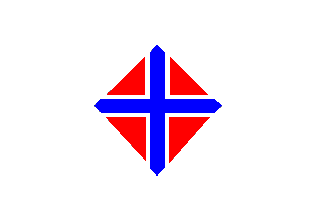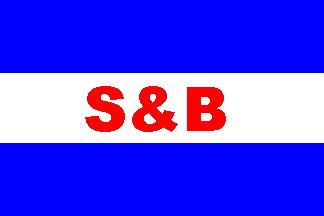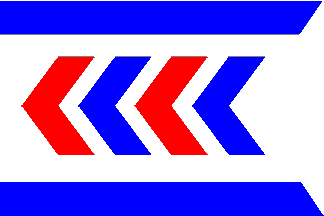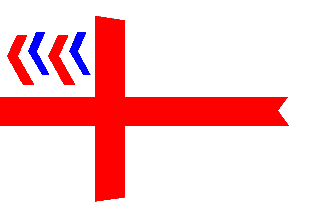![[Saint Line Ltd. (America) houseflag]](../images/g/gb~saint.gif) image
by Jarig Bakker,
based on the website of the National
Maritime Museum.
image
by Jarig Bakker,
based on the website of the National
Maritime Museum. 
Last modified: 2009-05-24 by rob raeside
Keywords: sr | deer | stag | sos | sc&co | sc | sh | chevrons (4) | s.ltd | bjs&co |
Links: FOTW homepage |
search |
disclaimer and copyright |
write us |
mirrors
![[Saint Line Ltd. (America) houseflag]](../images/g/gb~saint.gif) image
by Jarig Bakker,
based on the website of the National
Maritime Museum.
image
by Jarig Bakker,
based on the website of the National
Maritime Museum.
UK and Continent - South America;
Houseflag: white, with red St. Andrew's cross; white field edged red in center,
containing rising sun over Tudor rose.
Jarig Bakker, 17 October 2003
From the website of the National
Maritime Museum, the house flag of Saint Line Ltd (America), London. A white
rectangular flag with a red saltire. There is a white shield in the centre with
a red and yellow sun motif. The flag is made of a wool and synthetic fibre
bunting. It has a cotton hoist and is machine sewn."
Jarig Bakker, 27 August 2004
South American
Saint Line. Some sources show the saltire as reaching the edge of the flag. I
have come across a description of the emblem stating that the rising sun or
flame effect is in fact the upper half of a gold star with 5 point showing
surmounting the upper half of an orange estoile or star of wavy points with 6
showing in the appropriate spaces. The lower half of the design, also in gold,
is referred to as "a lower wheel shape" consisting of the outline only.
A Tudor Rose would certainly explain the background seeing that the
company was Welsh based. The 1961 US Navy publication shows orange in
place of red on the flag but there appears no reason for this. The
company seems to have been absorbed by Houlder Bros around
1970.
Neale Rosanoski, 24 May 2004
 image by Jarig Bakker, 12 December 2007
image by Jarig Bakker, 12 December 2007
The flag was red with a white line towards the top and bottom edges. In the
middle was a white rectangle with the letters SEGB in blue. SEGB were colliers
that used to run between the north east ports and London.
Mike Davison, 30 November 2007
The flag was red with a white line towards the top and bottom edges. In the
middle was a white rectangle with the letters SEGB in blue. The funnel was black
with a white band; this bore three narrow red lines to top and bottom and in the
centre a white rectangle outlined red, with SEGB in blue.
There is a history of the company's ships by D. Ridley Chesterton, 'Gas and
electricity colliers: the sea-going ships owned by the British gas and
electricity industries', published by the World Ship Society in 1984.
Ian Sumner, 11 December 2007
 image
by Jarig Bakker,
based on the website of the National
Maritime Museum.
image
by Jarig Bakker,
based on the website of the National
Maritime Museum.
From the website of the National
Maritime Museum, the house flag of South Georgia Co. Ltd. A white flag with
a red diamond in the centre on which is a white- bordered blue cross. The flag
is made of a wool and synthetic fibre bunting. It has a cotton hoist and is
machine sewn."
Loughran (1979) writes: "Chr. Salvesen & co.,
Ltd., had Norwegian origins, and the device of the center of the flag is derived
from the national flag of Norway. It owned the South Georgia Company."
Jarig Bakker, 29 August 2004
South Georgia Co. Ltd. was formed in 1916 whereas the parent company dates
from1846 when the Norwegian brothers Christian and Theodore Salvesen set up
business in Edinburgh. In shipping they were involved in whaling and post WW2
these interests declined until by 1990 they withdrew from shipping and are today
a logistics company. The flag is normally shown under the Salvesen name and the
earliest source I have come across is Reed 1901 which shows the flag as having a
blue border but this may be an error with Lloyds 1904 on showing the version as
shown here.
Neale Rosanoski, 13 February 2005
From
http://www.plimsoll.org/OnTheLine/ShippingLines/southernrailwaycompany/default.asp#2:
The London & South Western Railway, active since 1840, starts shipping in 1843
as the 'New South Western Steam Navigation Company'. Other railway firms start
cross-Channel and coastal shipping lines; various mergers occur. Finally, in
1923, "the London & South Western, London Brighton & South Coast and South
Eastern & Chatham Railway Companies merge to form the Southern Railway. The new
company operates trains and ships across the south east of England". When after
WWII the British Transport Commission assumes control of the railways, the
shipping activities follow (1948). The situation does not change on the
formation of British Rail, however its shipping activities come to an end when
Stena and Sealink UK acquire them (1979).
The Southern Railway house flag was blue with a red cross throughout, fimbriated
white, and white letters 'S' (upper hoist) and 'R' (lower fly).
Jan Mertens, 15 April 2005
 image
by Jarig Bakker,
based on the website of the National
Maritime Museum.
image
by Jarig Bakker,
based on the website of the National
Maritime Museum.
From the website of the National
Maritime Museum, the house flag of Stag Line Ltd, North Shields. A red
rectangular flag with the crest of a white stag. The flag is made of a wool and
synthetic fibre bunting. It has a cotton hoist and is machine sewn with the
motif printed. A rope and toggle is attached. The design dates from 1846 when
the company purchased its first vessel, a wooden scow named 'Stag'.
The company was named after its first vessel 'Stag', purchased in 1846 by
Captain Joseph Robinson. He shortly afterwards formed a management company,
Joseph Robinson & Co. The company ran small wooden barques, buying their first
steam tramp in 1875 and going over entirely to steam by 1879. From 'Camelia' of
1858 onwards, the company tended to favour flower names for its vessels.
A limited company was formed in 1895 but the firm remained in Robinson's hands
and was based in North Shields. After some losses during both world wars the
company continued to trade worldwide, particularly to Canada. It was also
involved in cable laying in New Zealand and the West Indies. The company was
taken over by Hunting Gibson Ltd in 1981. The remaining coasters were sold by
1983 and the joint management company went to James Fisher & Sons of Barrow in
1982."
Jarig Bakker, 31 August 2004
![[Star Offshore Services Marine Ltd. houseflag]](../images/g/gb~sosm.gif) image
by Jarig Bakker, 28 October 2005
image
by Jarig Bakker, 28 October 2005
Star Offshore Services Marine Ltd., Aberdeen - white flag, blue disk charged
with white 5-pointed star, between two "S"-shaped blocks.
Source:
Loughran (1995)
Jarig Bakker, 28 October 2005
![[State Line houseflag]](../images/g/gb~stal.gif) image by
Eugene Ipavec, 9 August 2008
image by
Eugene Ipavec, 9 August 2008
This shipping company is presented on
The Ships List
website. It was a British company sailing to the US from 1872 onwards,
partly American owned, naming its ships after US states. A few years later
adverse circumstances led to ships being chartered out or even sold; the company
was finally wound up, Allan Line buying what was left of the fleet in 1891.
A poster on this page shows the house flag: a blue straight-edged swallowtail,
horizontally edged red above white (top) and white above red (bottom); on the
blue field is placed a white initial ‘S’ accompanied by a rather smaller white
star near the hoist. Shown here is the relevant part of a passenger list, ‘State
of Indiana’ New York to Glasgow offered on eBay (item no. 6597754753, ended 22
Jan. 2006). The date on the list I cannot read but according to the seller (“ocliners”)
it was issued in 1884.
While the ‘S’ recalls the firm’s name, the colours and the star are certainly
examples of mixed British and US flag symbology.
Additional information (sinking of the ‘State of Florida’):
http://www.norwayheritage.com/p_ship.asp?sh=stafl
Jan Mertens, 19 March 2007
 image
by Jarig Bakker,
based on the website of the National
Maritime Museum.
image
by Jarig Bakker,
based on the website of the National
Maritime Museum.
From the website of the National
Maritime Museum, the house flag of Steel and Bennie Ltd., Glasgow. A
rectangular blue, white and blue triband with the red letters 'S & B' across the
central white stripe. The flag is made of a wool and synthetic fibre bunting. It
has a cotton hoist and is machine sewn."
Jarig Bakker, 31 August 2004
Based on Sampson (1957).
James Dignan, 19 October 2003
Stephenson Clarke & Associated Co.'s, Ltd.
Description: blue with red St. Andrew's cross; white letters S&CCo in each
quarter.
Jarig Bakker, 19 October 2003
Stephenson Clarke. A slightly different version is shown by the 1933 Lloyd
Reedereiflaggen cigarette card collection replacing the letters "S&CCo" as shown
with "CS&Co" but nobody else supports this version. However the company which
originated as Stephenson Clarke & Co. in 1865 and became Stephenson Clarke &
Associated Companies Ltd. in 1928, in 1945 changed to Stephenson Clarke Ltd.
leading to a change in flag with the letters cut to "S" (hoist) and "C" (fly).
Since then the name has changed in 1968 to Stephenson Clarke Shipping Ltd. and
then in 2001 to Stephenson Clarke Shipmanagement Ltd. but I do not know whether
there were changes to the flag as a result.
Neale Rosanoski, 24 May 2004
![[Putford Enterprises Ltd. houseflag]](../images/g/gb~scs0.gif) image by Jarig Bakker, 3 October 2005
image by Jarig Bakker, 3 October 2005
Stephenson Clarke Shipping Ltd., Newcastle-upon-Tyne - blue flag, red
saltire; at hoist and fly white "SC".
Loughran (1995)
Jarig Bakker, 3 October 2005
 image
by Jarig Bakker,
based on the website of the National
Maritime Museum.
image
by Jarig Bakker,
based on the website of the National
Maritime Museum.
From the website of the National
Maritime Museum, the house flag of Stevinson-Hardy. A blue rectangular flag
with a yellow diamond in the centre bearing the blue letters 'SH'. The flag is
made of a wool and synthetic fibre bunting. It has a cotton hoist and is machine
sewn."
Jarig Bakker, 31 August 2004
Based on Sampson (1957).
James Dignan, 11 October 2003
Based in Glasgow, Scotland
Phil Nelson, 11 October 2003
![[Stewart & Gray houseflag]](../images/g/gb~hfsgr.gif) image by Ivan
Sache, 12 March 2008
image by Ivan
Sache, 12 March 2008
Lloyds Book of House Flags and Funnels (1912)
shows the house flag of "Stewart & Gray" (#106, p. 42), a company based in
Glasgow (Scotland), as divided per saltire white-red-white-red, with the red
letters "S"and "G" in the left and right white triangles, respectively.
Ivan Sache, 12 March 2008
 image
by Jarig Bakker,
based on the website of the National
Maritime Museum.
image
by Jarig Bakker,
based on the website of the National
Maritime Museum.
From the website of the National
Maritime Museum, the house flag of Stirling Shipping Co. Ltd., Glasgow. A
red, white and red tricolour flag. On the central white stripe, there are two
narrow, wavy vertical blue lines running parallel. The flag is made of a wool
and synthetic fibre bunting. It has a cotton hoist and is machine sewn. The
central motif is in polyester and cotton material. A rope and toggle is
attached. The wavy lines are said to represent the River Clyde. The flag is
similar to that of the associated company, Harrisons (Clyde) Ltd."
Jarig Bakker, 31 August 2004
Source: Brown's Flags and Funnels [Wedge 1926]
W.H. Stott, Limited, Liverpool - red swallowtail, white "S".
Jarig Bakker, 24 January 2005
Based on Sampson (1957).
James Dignan, 8 October 2003
Houseflag: white burgee, blue border, top and bottom, with red, blue, red and
blue chevrons. Sailing: United Kingdom-Persian Gulf.
Jarig Bakker, 9 October 2003
Brown 195: Strick Line, Ltd., London.
Funnel: Black, a wide white band with four shortened chevrons pointing to the
viewers left, alternating from the left, red and blue.
Flag: 2:3, a forked white flag with blue borders along the fly-wise edges, four
shortened chevrons pointing towards the hoist, alternating red and blue. The
chevrons, together with the spaces between them that have the same width as the
bars of the chevrons, fill almost the entire depth of the flag. The chevrons and
the fork are all orthogonal. (It may be that the intention is that only a single
width separates the last chevron from the fly edges, but the print quality of
Browns' is not sufficient to be sure.)
James's images is more like:
Flag: 2:3, a forked white flag with blue borders along the fly-wise edges, four
shortened chevrons pointing towards the hoist, alternating red and blue. The
chevrons, together with the spaces between them that have the same width as the
bars of the chevrons, fill approximately half the depth of the flag. The fork is
orthogonal, the chevrons are obtuse.
Peter Hans van den Muijzenberg, 20 October 2003
 image
by Jarig Bakker,
based on the website of the National
Maritime Museum.
image
by Jarig Bakker,
based on the website of the National
Maritime Museum.
From the website of the National
Maritime Museum, the house flag of the Strick Line Ltd., London. A white,
swallow-tailed burgee with a blue border at the top and bottom edge. Four
chevron stripes, alternatively red and blue are placed across the centre. The
flag is made of a wool and synthetic fibre bunting. It has a cotton hoist and is
machine sewn. A rope and two Inglefield clips is attached.
The line was founded by Frank Clarke Strick (1849-1943), a Swansea businessman
with a background in coal exporting and shipbroking. He began his career as a
shipowner in 1887, his vessels carrying coal to the Mediterranean ports and the
Gulf and importing iron ore. By 1913, Strick's companies, La Commerciale Steam
Navigation Co. Ltd, The Anglo-Arabian and Persian Steamship Co. Ltd and
Anglo-Algerian Steam Ship Co. (1896) Ltd had all merged to form Strick Line Ltd.
The company was sold in 1919 and shortly afterwards became Strick Line (1923)
Ltd, a part of the P&O group. In 1946 the company name reverted to Strick Line
Ltd. In the post-war period the company traded worldwide, and in particular with
the Gulf States. It was taken over by P&O in 1972 and went out of existence in
1974."
Jarig Bakker, 31 August 2004
Regarding the variation in the shape of the Strick Line houseflag, the one I
remember while serving with them from 1958 until we were taken over by P&O is
this one with the fork taking the whole fly not just the white band and the four
chevrons occupying most of the white band. The Commodores pennant (see below)
was as per the small version found by Neale Rosanoski with the chevrons in line
in the upper canton at the hoist not staggered as in the other version (this I
do know as I was the 3rd. Mate on the 1960 Kohistan which was the first ship to
wear it!) The funnels had five chevrons which met at front and back starting
with red. This led to a typical crude seaman's description of "a kiss at the
front and a **** behind"! Two stories result from this - at the end of the war
all masters tried to find the paint to return their ships to their proper
colours, one even managed to paint the hull black not knowing that the company
had decided to retain grey, seemingly only one ship got the funnel correct. In
later years senior management heard of the description of the funnel above and
changed the last two ships to four chevrons per side so that they no longer met.
Only the cost involved stopped the whole fleet being changed!
Alasdair McCulloch, Master Mariner (Rtd.), 7 March 2007
![[Frank C. Strick & Co. houseflag]](../images/g/gb~s732b.gif) image located by Neale Rosanoski
image located by Neale Rosanoski
Frank C. Strick & Co. Most sources, Talbot-Booth being the major exception, show
the fork taking all of the fly rather than just the white band. All usual
sources agree that the chevrons occupy most of the band. The funnel view given
only applies to the port view, starboard also shows the chevrons pointing
forward. The company had a commodore's flag being a white tapered swallowtail, a
red cross and in the canton the four red-blue chevrons. The company was absorbed into P&O (owners from 1919) in 1972 and
although P&O appear to have used their name for registering ships until the
early 1980s I understand that the flag was not used after 1972.
Neale Rosanoski, 24 May 2004
 image
by Jarig Bakker, 28 December 2004
image
by Jarig Bakker, 28 December 2004
Strick Steamship Co. Ltd. Commodore's flag - white tapered swallowtail, red
cross; in canton four chevrons RBRB note: Commodore's flag is flown separately
from the ordinary flag, from the foremast.
From Scott, R.M., The Caltex book of Flags and Funnels, Capetown, Caltex Africa
Ltd. (1959).
Jarig Bakker, 28 December 2004
![[Suffolk Marine Ltd. houseflag]](../images/g/gb~sufma.gif) image by Jarig
Bakker, 15 February 2006
image by Jarig
Bakker, 15 February 2006
Suffolk Marine Ltd., Lowestoft - Israeli-style blue-white flag; in center
white "S".
Source: Loughran (1995)
Jarig Bakker, 15 February 2006
Source: Brown's Flags and Funnels [Wedge 1926]
Summersfield Steamship Company Limited, Liverpool. White flag bordered red; in
the center "S.Ltd." in red.
Jarig Bakker, 15 January 2005
![[Supervessel Express houseflag]](../images/g/gb~supv1.gif) image
by Eugene Ipavec, 23 November 2007
image
by Eugene Ipavec, 23 November 2007
![[Supervessel Express houseflag]](../images/g/gb~supv2.gif) image
by Eugene Ipavec, 23 November 2007
image
by Eugene Ipavec, 23 November 2007
Supervessel Express Co., Ltd at Southampton (GB) has a
website, showing a
flag resembling that of the Syrian firm Al Fahel:
“SUPERVESSEL EXPRESS LTD specializes in shipbrokering and chartering with the
co-operation of Al Fahel Shipping Co.” The firm is a charterer and ship broker.
This page,
oddly, shows two variants (drawings) of the house flag. In the upper left corner
of page: horizontally divided blue-yellow-blue in a 1:2:1 ratio it seems, a
white oval in the centre partly extending into the blue stripes and on which is
placed a blue stylized initial ‘S’ (serifed). Not only the oval, Al Fahel-like,
is leaning to the right but the initial is shadowed in grey as well. On the
right, lower down, we find a variant: horizontally divided blue-yellow-blue, a
white diamond in the centre partly extending into the blue stripes and on which
is placed a blue stylized initial ‘S’ (serifed).
Describing these flagoids may seem rather fruitless – even if
a table flag shows up confirming one or the other we still do not know if a
life-size one exists – but at least they are on record.
Jan Mertens, 20 November 2007
![[Summersfield Steamship Company Limited houseflag]](../images/g/gb~jbs.gif) image by Jarig Bakker, 17 April 2006
image by Jarig Bakker, 17 April 2006
B.J. Sutherland & Co., Ltd., Newcastle on Tyne.
Wedge 1926,
Wedge (1951), Loughran (1979), and
Talbot-Booth (1937) all have
per saltire red (top and bottom) and blue (hoist and fly), with the letters
positioned as shown (all white). According to Loughran it was founded 1892 and
ceased operations in 1955.
Jarig Bakker, 17 April 2006
![[E.J. Sutton & Co houseflag]](../images/g/gb~ejsc1.gif) image by
Eugene Ipavec, 8 February 2009
image by
Eugene Ipavec, 8 February 2009
![[E.J. Sutton & Co houseflag]](../images/g/gb~ejsc2.gif) image by
Eugene Ipavec, 8 February 2009
image by
Eugene Ipavec, 8 February 2009
Browns Flags and Funnels, 1951 edition (wed51).
The funnel in Browns Flags and Funnels, 1951
edition, is black, with a yellow band on which are 1 and 2 half dark blue
diamonds. The house flag in the book is white with a black diamond on which is
inscribed EJS & Co, in white over two lines. An anoymous painting submitted by a
visitor to this site showed a flag with the letters on two lines.
Ralph
Kelly, 7 February 2009